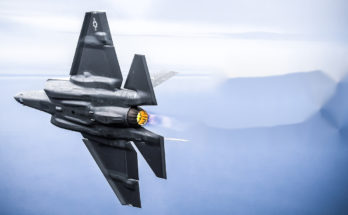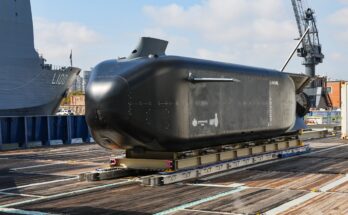by Dan Darling, Forecast International
Following a prolonged period of budgetary reductions, Europe’s larger defense environment appears to have reached its low threshold. But instead of a marked rebound in investment, the market as a whole will remain largely flat over the near term, according to the latest Europe Military Markets analysis by Forecast International.
Though the eurozone economic recovery from the 2008 global financial crisis remains a relatively anemic one, efforts by governments to trim budget deficits in the wake of sovereign debt concerns have successfully narrowed imbalances. Yet while treasuries have a bit more financial breathing room, this is not expected to result in sudden infusions of funding earmarked for defense, as maintaining budgetary discipline remains the overriding prerogative for many European governments.
While more robust defense spending is not apparent on the immediate horizon, the healthier fiscal ledgers should allow many governments to stem the slide in military investment that saw the defense expenditures of the 28 European Union members shrink by 3.5 percent between 2008 and 2013. Instead, from 2014 through 2018, the combined EU28 defense market should grow nominally by about $17 billion, or roughly less than 1 percent annually in real terms.
“The post-financial crisis period has resulted in a concentrated effort throughout the finance ministries of Europe to find areas of savings,” says Forecast International’s Europe Military Markets Analyst Dan Darling. “Inevitably, one of the areas where year-on-year spending has been frozen or cut is defense. To be seen shrinking defense was hardly considered a political liability if doing so meant sparing social services and welfare nets from sharper cutbacks. So while overall spending in the EU28 actually grew by 4 percent between 2009 and 2013, the portion allocated for military spending fell by 1.7 percent in real terms.”
A second economic slump hitting the eurozone (2012-2013) further accelerated the defense budget cuts and forced restructurings already in motion across Europe. These restructurings left many European armies with fewer personnel and reduced capabilities in troop transport and logistical support, and with a blunted reservist element.
“As funding pressures increased, many defense ministries had little option but to make difficult choices as to what capabilities to retain or shed and how best to configure their armies going forward,” Darling notes.
The shrunken military footprint has meant more areas for an assertive Russia to probe along its former Soviet domain and more stress on the deployable elements of the 21 dual EU-NATO members as they seek to fill security gaps and aid ailing governments in areas as far apart as the Central African Republic and Afghanistan.
While the countries of Eastern Europe view Russia as the preeminent threat to their own security and are reexamining their military investment practices, the traditional European defense powers are intent on continuing the restructurings of their own armed forces and preventing regional brushfires in Africa, the Near East, and Ukraine from spreading.
For countries like Estonia, Latvia, Lithuania and Poland – each predisposed by their respective histories to see the worst in Russia’s actions and intentions, the need to counter the threat presented by Moscow is of paramount national security concern. But while the recidivist tendencies exhibited by Vladimir Putin’s Russia elicit worry among those EU-NATO nations once held under Soviet domination and are of concern to the Alliance at large, Russia itself is not seen as a direct military threat to the territorial sovereignty of Britain, France, Germany or Italy. As a result, rebounding defense budgets and expanding inventories of jet fighters, tanks, and warships for the armies of these nations are not in the offing. Instead, undertaking missions to manage threats along Europe’s eastern periphery is something considered to be manageable via solutions derived within existing budgets and force structures, therefore requiring of them no massive increases in financing, personnel or equipment.
“What’s already been undertaken in the past decade(s) will not be reversed,” Darling notes. “It is the new reality. While Russia certainly presents a challenge for the EU and NATO, it is not seen in Berlin, London or Paris as a threat on the level of the former Soviet Union. Therefore, the more powerful defense nations in Europe are in no rush to halt or reverse plans for smaller, well-equipped armies that provide them with operational flexibility. For now, their future defense spending projections reflect a more conservative approach than followed by their eastern peers, who are starting from very low spending bases as they seek to bolster military budgets in future years.”
Thus while five EU-NATO nations – Estonia, Latvia, Lithuania, Poland and Romania – have expressed a commitment to raise their military budgets up to (or near to) the NATO minimum standard of 2 percent of GDP on an annual basis in the wake of events in Ukraine, their combined defense spending figure of $13.6 billion for 2014 represents less than 33 percent of what France is allocating alone.
“With the eurozone economy registering barely any growth so far in 2014 and euro-area government debt at 94 percent, sharp spikes capital investment toward defense will not be forthcoming,” Darling adds.
“Since massive budgetary injections are not on the horizon, the focus in respective European defense ministries should be on how to spend the money allocated in the most practical manner. That would start by reexamining the way in which funding is proportioned between personnel, operations and maintenance, and modernization and defense research. Achieving a more balanced spending ratio that allows for higher military readiness and a greater percentage of deployable personnel – as well as their sustainment in-theater – should be the focus going forward.”
For 50 years, Forecast International intelligence reports have been the aerospace and defense industry standard for accurate research, analysis, and projections. Our experienced analysts compile, evaluate, and present accurate data for decision makers. FI's market research reports offer concise analysis of individual programs and identify market opportunities. Each report includes a program overview, detailed statistics, recent developments and a competitive analysis, culminating in production forecasts spanning 10 or 15 years. Let our market intelligence reports be a key part of reducing uncertainties and mastering your specific market and its growth potential. Find out more at www.forecastinternational.com



